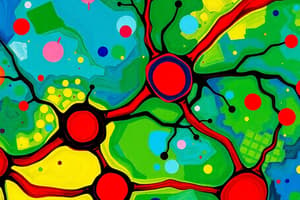Podcast
Questions and Answers
What is the first stage of cell signaling?
What is the first stage of cell signaling?
- Transduction
- Reception (correct)
- Response
- Activation
In the context of cell signaling, what is the role of kinase enzymes?
In the context of cell signaling, what is the role of kinase enzymes?
- To facilitate receptor binding
- To degrade signaling proteins
- To add phosphate groups to molecules (correct)
- To inhibit signal transduction
Which of the following describes the process that translates receptor-ligand interaction into a change in behavior or gene expression?
Which of the following describes the process that translates receptor-ligand interaction into a change in behavior or gene expression?
- Signal transduction (correct)
- Signal amplification
- Cellular metamorphosis
- Gene modification
What happens during the transduction stage of cell signaling?
What happens during the transduction stage of cell signaling?
Which of the following molecules is likely involved in the signal transduction pathway?
Which of the following molecules is likely involved in the signal transduction pathway?
What is the main function of the signal transduction pathway?
What is the main function of the signal transduction pathway?
What occurs during the response stage of cell signaling?
What occurs during the response stage of cell signaling?
What initiates the reception stage of cell signaling?
What initiates the reception stage of cell signaling?
What is the primary role of the first messenger in a signaling pathway?
What is the primary role of the first messenger in a signaling pathway?
Which molecule is produced as a result of activating adenylyl cyclase?
Which molecule is produced as a result of activating adenylyl cyclase?
What type of molecules can serve as secondary messengers?
What type of molecules can serve as secondary messengers?
Which of the following is the correct sequence of the stages of cell signaling?
Which of the following is the correct sequence of the stages of cell signaling?
What is the role of protein kinases in the signaling pathway?
What is the role of protein kinases in the signaling pathway?
Which statement is true regarding the transduction stage of cell signaling?
Which statement is true regarding the transduction stage of cell signaling?
What can trigger cellular responses in a signaling pathway?
What can trigger cellular responses in a signaling pathway?
What happens during the reception stage of cell signaling?
What happens during the reception stage of cell signaling?
What is the primary role of protein kinases in phosphorylation cascades?
What is the primary role of protein kinases in phosphorylation cascades?
Which enzyme is responsible for the removal of phosphates from proteins?
Which enzyme is responsible for the removal of phosphates from proteins?
How do signal molecules typically influence proteins in phosphorylation cascades?
How do signal molecules typically influence proteins in phosphorylation cascades?
What is produced when a protein kinase transfers a phosphate group from ATP to an inactive protein kinase?
What is produced when a protein kinase transfers a phosphate group from ATP to an inactive protein kinase?
What is the significance of phosphorylation cascades in signal transduction pathways?
What is the significance of phosphorylation cascades in signal transduction pathways?
Which of the following best describes the relationship between protein kinases and ATP in phosphorylation processes?
Which of the following best describes the relationship between protein kinases and ATP in phosphorylation processes?
Which amino acids are primarily involved in the phosphorylation processes described?
Which amino acids are primarily involved in the phosphorylation processes described?
What happens to the energy released from ATP during phosphorylation?
What happens to the energy released from ATP during phosphorylation?
What is the main role of cell signaling in gene expression?
What is the main role of cell signaling in gene expression?
What happens to a receptor when a signaling molecule binds to it?
What happens to a receptor when a signaling molecule binds to it?
Which outcome is NOT typically associated with cellular response after signal transduction?
Which outcome is NOT typically associated with cellular response after signal transduction?
How can the same ligand produce different cellular responses?
How can the same ligand produce different cellular responses?
What is the purpose of a phosphorylation cascade in a signaling pathway?
What is the purpose of a phosphorylation cascade in a signaling pathway?
What occurs during the inactive stage of a transcription factor?
What occurs during the inactive stage of a transcription factor?
Which of the following best describes the specificity of cell signaling?
Which of the following best describes the specificity of cell signaling?
What is dephosphorylation primarily associated with in signaling pathways?
What is dephosphorylation primarily associated with in signaling pathways?
What type of receptors are responsible for the rapid transmission of signals across synapses in the nervous system?
What type of receptors are responsible for the rapid transmission of signals across synapses in the nervous system?
Which of the following molecules often serves as a molecular switch in intracellular signaling?
Which of the following molecules often serves as a molecular switch in intracellular signaling?
What do G-protein-linked receptors activate as part of their function?
What do G-protein-linked receptors activate as part of their function?
What happens when a neurotransmitter binds to an ion-channel-linked receptor?
What happens when a neurotransmitter binds to an ion-channel-linked receptor?
Which signaling molecules act as second messengers in the relay systems formed by signaling cascades?
Which signaling molecules act as second messengers in the relay systems formed by signaling cascades?
Which type of receptor acts as an enzyme or associates with enzymes inside the cell?
Which type of receptor acts as an enzyme or associates with enzymes inside the cell?
What is a primary outcome of the signal generated by ion-channel-linked receptors?
What is a primary outcome of the signal generated by ion-channel-linked receptors?
Which type of signaling proteins primarily relay signals received via G-protein-linked or enzyme-linked receptors?
Which type of signaling proteins primarily relay signals received via G-protein-linked or enzyme-linked receptors?
Flashcards are hidden until you start studying
Study Notes
Cell Signaling Stages
-
Cells receive signals and go through three stages: reception, transduction, and response.
-
Reception: The target cell detects a signaling molecule from outside the cell. This occurs when a signaling molecule binds to a receptor protein, causing it to change shape.
-
Transduction: The signal is converted into a form that can trigger a specific cellular response. This often involves a series of relay molecules that activate each other in a chain reaction.
-
Response: The cell's behavior is altered in some way. This could involve activating an enzyme, altering gene expression, or changing the cell's shape.
-
This process is called a signal transduction pathway.
Kinases and Phosphatases
-
Kinases are enzymes that add phosphate groups to proteins. This process called phosphorylation can activate or inactivate a protein, altering its function.
-
Phosphatases are enzymes that remove phosphate groups from proteins. This process called dephosphorylation can also activate or inactivate a protein.
-
Kinases and phosphatases play crucial roles in signal transduction pathways, acting as molecular switches to turn proteins on and off.
Signal Transduction Pathway
-
The signal transduction pathway converts extracellular information into an appropriate cellular response.
-
It is composed of:
- Signals (extracellular and intracellular)
- Receptors
- Signaling proteins
- Second messenger molecules
Protein Phosphorylation and Dephosphorylation
-
Many signal pathways involve phosphorylation cascades.
-
A series of protein kinases add a phosphate group to the next protein in line, activating it.
-
Phosphatase enzymes then remove the phosphates for homeostasis.
Second Messengers
-
Second messengers are small, non-protein, water-soluble molecules or ions that act as secondary messengers.
-
They are often involved in amplifying the signal, creating a larger response.
-
Examples of second messengers include cyclic AMP (cAMP), calcium ions (Ca2+), and diacylglycerol (DAG).
The Specificity of Cell Signaling
-
A signaling molecule binding to its receptor causes a conformational change in the receptor, which triggers a cellular response.
-
The same ligand can bind to receptors on different cell types and cause different responses.
-
Different ligands binding to different receptors can produce the same cellular response.
G-protein-linked Receptors
-
G-protein-linked receptors activate a class of membrane-bound proteins called G-proteins.
-
These proteins act as molecular switches, cycling between an active (GTP-bound) and inactive (GDP-bound) state.
Enzyme-linked Receptors
-
Enzyme-linked receptors either act as an enzyme themselves or are associated with enzymes inside the cell.
-
When these receptors bind to signaling molecules, they activate the associated enzymes.
Ion-channel-linked Receptors
-
Ion-channel-linked receptors are responsible for the rapid transmission of signals across synapses in the nervous system.
-
These receptors convert chemical signals into electrical ones by opening or closing channels for specific ions.
Intracellular Signaling Proteins
-
Many intracellular signaling proteins act as molecular switches.
-
Some serve as chemical transducers, generating a new type of signal in response to an existing one.
Studying That Suits You
Use AI to generate personalized quizzes and flashcards to suit your learning preferences.




